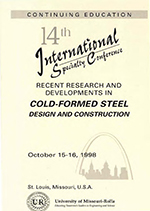Session Dates
15 Oct 1998
Abstract
The work leading to a European design code for pallet racking started almost 25 years ago. Many difficulties were encountered in the early days of this work. Notable were the absence of a consistent safety philosophy between the various countries of Europe and the existence of procedures with which the manufacturers were comfortable but which were potentially unsafe. There were also difficulties in defining acceptable standard. test procedures. The emergence of Eurocode 3, especially Part 1.3 dealing with cold formed sections, provided a new impetus to the work because here was a European code which provided the required basis for the design code. Accordingly, Section X of the Federation Europeenne de la Manutention (FEM) commissioned technical "experts" to draft the new code under the direction of its technical committee. It was a requirement that the code should be, as far as possible, compatible with Eurocode 3. In the early stages of the work, there were a group of these experts but, for most of the drafting period, only the authors of this paper were active. The code was essentially complete in mid 1997 and, since then, it has been subject to trial use by the member companies of FEM and open to consequential comments. However, in May 1997, a significant meeting took place. FEM and the Rack Manufacturers Institute (RMI) of the USA sponsored a meeting between the first author and RMI's own "expert", Professor T Pekoz of Cornell University. The intention was to compare the two codes and to report on the potential for possible future harmonisation. It emerged that the two codes were about as different as two codes covering the design of the same structural elements could be! However, the "experts" took a positive view of the situation and concluding that, from the technical point of view, there was no reason why the two codes could not be brought into convergence and that, in the meantime, we could each learn from the others experience. Consequently, at this late stage in the evolution of the European code, a number of significant changes were made where it was considered that the European code could advantageously be made more compatible with the RMI code without in any way impairing its technical rigour. This paper introduces the new European design code for pallet racking and compares and contrasts it with its American counterpart. As a pallet rack is a particularly demanding application of cold-formed steel sections, it is hoped that the designers of other cold-formed products may also learn from some of the approaches described in this paper.
Department(s)
Civil, Architectural and Environmental Engineering
Research Center/Lab(s)
Wei-Wen Yu Center for Cold-Formed Steel Structures
Meeting Name
14th International Specialty Conference on Cold-Formed Steel Structures
Publisher
University of Missouri--Rolla
Document Version
Final Version
Rights
© 1998 University of Missouri--Rolla, All rights reserved.
Document Type
Article - Conference proceedings
File Type
text
Language
English
Recommended Citation
Godley, M. H. R. and Davies, J. Michael, "A European Design Code for Pallet Racking" (1998). CCFSS Proceedings of International Specialty Conference on Cold-Formed Steel Structures (1971 - 2018). 1.
https://scholarsmine.mst.edu/isccss/14iccfsss/14iccfsss-session5/1
A European Design Code for Pallet Racking
The work leading to a European design code for pallet racking started almost 25 years ago. Many difficulties were encountered in the early days of this work. Notable were the absence of a consistent safety philosophy between the various countries of Europe and the existence of procedures with which the manufacturers were comfortable but which were potentially unsafe. There were also difficulties in defining acceptable standard. test procedures. The emergence of Eurocode 3, especially Part 1.3 dealing with cold formed sections, provided a new impetus to the work because here was a European code which provided the required basis for the design code. Accordingly, Section X of the Federation Europeenne de la Manutention (FEM) commissioned technical "experts" to draft the new code under the direction of its technical committee. It was a requirement that the code should be, as far as possible, compatible with Eurocode 3. In the early stages of the work, there were a group of these experts but, for most of the drafting period, only the authors of this paper were active. The code was essentially complete in mid 1997 and, since then, it has been subject to trial use by the member companies of FEM and open to consequential comments. However, in May 1997, a significant meeting took place. FEM and the Rack Manufacturers Institute (RMI) of the USA sponsored a meeting between the first author and RMI's own "expert", Professor T Pekoz of Cornell University. The intention was to compare the two codes and to report on the potential for possible future harmonisation. It emerged that the two codes were about as different as two codes covering the design of the same structural elements could be! However, the "experts" took a positive view of the situation and concluding that, from the technical point of view, there was no reason why the two codes could not be brought into convergence and that, in the meantime, we could each learn from the others experience. Consequently, at this late stage in the evolution of the European code, a number of significant changes were made where it was considered that the European code could advantageously be made more compatible with the RMI code without in any way impairing its technical rigour. This paper introduces the new European design code for pallet racking and compares and contrasts it with its American counterpart. As a pallet rack is a particularly demanding application of cold-formed steel sections, it is hoped that the designers of other cold-formed products may also learn from some of the approaches described in this paper.



